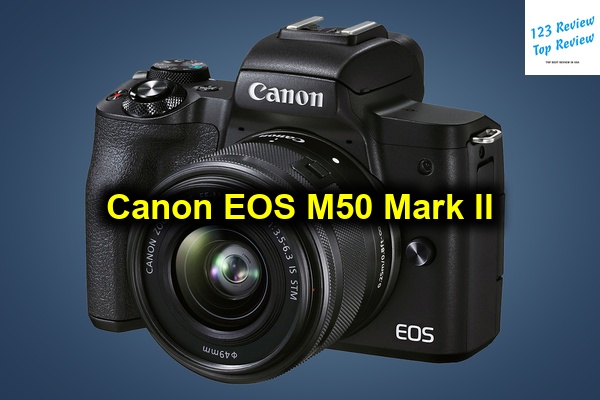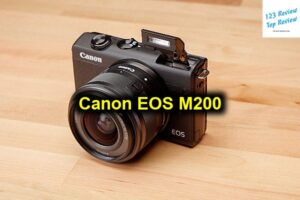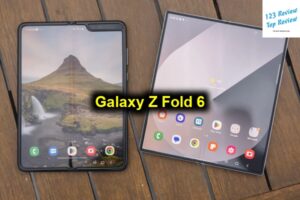The Canon EOS M50 Mark II is a significant player in the landscape of entry-level mirrorless cameras. It caters to a broad range of users, from photography enthusiasts and vloggers to those stepping up from smartphone photography.

In this article, 123 Review delves deep into the aspects that make the EOS M50 Mark II a compelling option in its category.
Design and Build Quality
Ergonomics and Handling
The Canon EOS M50 Mark II is designed with user comfort and ease of handling in mind. Its ergonomic design includes a pronounced handgrip, providing a firm hold that helps in steady shooting, which is crucial for creating shake-free photographs and videos. The grip fits naturally in the hands, allowing for a relaxed shooting posture that is less likely to result in hand fatigue during long sessions.
The control layout is intuitive, with buttons and dials sensibly positioned around the camera body. This ensures that users have quick access to frequently used functions without having to navigate through complicated menus. For instance, the mode dial is easily accessible, allowing users to swiftly switch between different shooting modes.
In terms of handling, the Canon EOS M50 Mark II proves exceptional. It offers a quick learning curve for beginners, giving them the confidence to explore more sophisticated photography techniques. The tactile feedback from the shutter button and other controls enhances the overall user experience, making it both responsive and enjoyable.
Material and Durability
Constructed largely from high-quality polycarbonate, the Canon EOS M50 Mark II balances lightness with durability. While it might not boast the high-end build of professional DSLRs, the camera feels solid in hand, conveying a sense of reliability. This robust feeling is important for users who need a camera that can handle the occasional bumps and dings of regular use.
The design, however, does not include weather sealing, meaning users must exercise care in wet or dusty conditions. Despite this, the M50 Mark II manages to withstand standard wear and tear, marking it as a dependable companion for casual photographers.
Size and Weight Comparison
One of the most appealing features of the Canon EOS M50 Mark II is its compact form factor. Weighing approximately 387 grams (including battery and memory card), it stands as a lightweight alternative to bulkier DSLRs. The dimensions—116.3 x 88.1 x 58.7 mm—allow it to fit into small bags with ease, making it a favored choice for travelers or street photographers who prefer to keep their gear unobtrusive.
This lightweight design does not compromise on functionality, making it an excellent choice for vloggers and mobile photographers who require gear that can be maneuvered easily over extended periods. The reduced weight contributes to less strain on the user’s shoulder and neck when carried over long durations, positioning the M50 Mark II as a travel-friendly camera.
Performance
Image Sensor and Processing
At the core of the Canon EOS M50 Mark II is a 24.1-megapixel APS-C CMOS sensor. This sensor ensures high-resolution imagery that captures intricate details and vibrant colors. Coupled with the DIGIC 8 image processor, the camera delivers superior image quality with effective noise reduction and color accuracy.
This processing power translates to quick shooting speeds, allowing for continuous bursts of up to 10 frames per second. This feature is highly beneficial when photographing fast-moving subjects such as in sports or wildlife scenarios. The processor’s capabilities ensure that each frame in a burst is captured with clarity, maintaining the integrity of the colors and details throughout the sequence.
Autofocus System
The Canon M50 Mark II features an enhanced Dual Pixel CMOS AF system, which provides fast and precise autofocus. This AF technology allows for smooth subject tracking across 99 points, extending to 143 points with certain lens configurations. The camera excels in maintaining focus on moving subjects, even in complex backgrounds or challenging lighting conditions.
Moreover, the inclusion of eye detection AF helps ensure portrait subjects remain sharply focused, with the camera prioritizing eye detail automatically. This function is crucial for portrait shooters aiming for professional-level precision in their work, and it works effectively when shooting both stills and videos.
Low-Light Performance
Low-light performance is a critical area where the Canon EOS M50 Mark II excels. It offers an ISO range of 100 to 25,600, expandable to 51,200, which facilitates shooting in dimly lit environments while maintaining reasonable noise levels. The DIGIC 8 processor aids in noise reduction, ensuring images remain clear and sharp with minimal loss of detail even at higher ISO settings.
This capability is particularly valuable for event and night photographers who often encounter varying light conditions. The ability to shoot in low-light without a significant drop in image quality or sharpness makes the M50 Mark II highly versatile.
Video Features
4K Video Capabilities
The Canon EOS M50 Mark II supports 4K video recording, though with specific limitations that videographers should note. The sensor crops significantly in 4K mode, and Dual Pixel autofocus is unavailable, relying instead on contrast-detect AF which is less efficient. Despite these drawbacks, the M50 Mark II remains a suitable choice for 4K shooting when high resolution is prioritized over focusing speed and frame coverage.
For most users, the Full HD 1080p video capabilities are more compelling, providing excellent autofocus performance and uninterrupted recording. With a variety of frame rates, including 24p, 30p, and 60p, the camera accommodates multiple shooting styles, from cinematic to high-action video.
Streaming Options
In response to the increasing demand for live streaming capabilities, the Canon EOS M50 Mark II offers enhanced streaming features. A clean HDMI output simplifies the connection to external recorders and live stream setups. Additionally, it supports webcam functionality through a USB connection, making it easy to deliver high-quality video on platforms like YouTube Live and Zoom.
This integration appeals especially to content creators and streamers who require seamless transitions between capturing and live streaming content. The capability to output full-resolution, latency-free signals ensures users can maintain professional standards during live broadcasts.
Frame Rate and Quality
Videographers will appreciate the range of frame rate options offered by the Canon EOS M50 Mark II. Users can select from several settings, including 24p, 30p, and 60p in Full HD, allowing for flexibility in creativity and storytelling. These choices accommodate both traditional video projects and high-frame-rate content aimed at capturing smooth motion.
Canon’s celebrated color science is evident in the video output, with videos exhibiting vibrant, natural hues that require minimal grading. The camera’s ability to maintain color accuracy alongside its enhanced image stabilization features ensures crisp, smooth footage across a variety of filming scenarios.
Usability
Menu System and Controls
Canon continues its heritage of user-friendly camera interfaces with the EOS M50 Mark II. The menu layout is clear and intuitive, providing easy navigation that simplifies accessing and adjusting settings. Options are logically organized, which is particularly helpful for those new to using interchangeable lens cameras.
Advanced users can appreciate the extent of customization available, enabling settings to match their specific shooting preferences. This adaptability extends to assigning custom functions to various buttons, allowing photographers to configure their M50 Mark II for rapid access to frequently used settings.
Touchscreen Functionality
The 3.0-inch vari-angle touchscreen display is a standout feature of the Canon EOS M50 Mark II. This high-resolution screen supports touch input, which simplifies focus point selection through tap-to-focus capabilities. The vari-angle design is particularly advantageous for vloggers and photographers composing from high or low positions, ensuring flexibility in framing.
The responsive touchscreen also contributes to a more efficient workflow, allowing photographers and videographers to swipe through images and adjust settings swiftly. Its ability to flip out and rotate is especially beneficial for selfie video shoots and creative angles, marking it as a valuable tool for creators.
Battery Life
The battery life of the Canon EOS M50 Mark II is serviceable for its class, providing approximately 305 shots per charge. While this is adequate for casual use, users planning long shoots, or extensive videography sessions might need to carry spare batteries or utilize the USB charging option to extend operational time.
Despite being on the moderate end of the spectrum for battery longevity, the provision for USB charging offers flexibility by allowing charging from power banks when on the go, enhancing the camera’s usability during travel-intensive projects.
Photography Features
Image Quality and Dynamic Range
The Canon EOS M50 Mark II impresses in the realm of image quality, capturing high-resolution photos with vibrant colors and extensive detail. The dynamic range is commendable, allowing photographers to capture a wide array of tonal variation and maintain detail in both highlights and shadows. This is particularly useful for landscape photographers who require the capacity to depict scenes with varying light intensities accurately.
The camera’s performance in reproducing colors naturally is a testament to Canon’s sophisticated color science, which provides a strong foundation for artistic expression without necessitating extensive post-processing.
Shooting Modes and Customization
The shooting modes on the M50 Mark II are diverse, accommodating a range of photography styles and preferences. It offers standard modes like Aperture Priority, Shutter Priority, and Manual, in addition to specialized scenes such as Portrait and Landscape, catering to different creative needs. Each mode is fine-tuned to optimize settings for the intended use, helping beginners achieve better results while experimenting with various techniques.
Customization extends beyond modes, allowing users to set preferred configurations and recall them instantly. The My Menu feature enables frequent functions to be saved for easy access, further illustrating Canon’s commitment to enhancing user experience and simplifying camera operation.
Lens Compatibility
Versatility is a significant advantage of the Canon EOS M50 Mark II, thanks to its EF-M lens mount. This mount supports a variety of EF-M lenses, which cover essential photography needs. Importantly, with a lens adapter, the camera becomes compatible with Canon’s extensive EF and EF-S lens series, greatly expanding creative possibilities.
This flexibility facilitates experimentation and growth, allowing photographers to explore different focal lengths and lens qualities as they refine their skills. The ability to leverage high-quality glass from Canon’s vast lens library ensures users maximize the camera’s capabilities over time.
Target Audience
Ideal Users
The Canon EOS M50 Mark II is designed with a versatile audience in mind. It appeals to entry-level photographers transitioning from smartphone cameras by providing a user-friendly DSLR alternative. Those interested in vlogging or content creation also benefit from its lightweight design and comprehensive video features, making it well-suited for creators exploring multi-platform storytelling.
Enthusiast photographers who require a second camera can also benefit from the M50 Mark II’s portable design and robust feature set, which make it a suitable backup to more sophisticated systems.
Comparison with Other Entry-Level Cameras
In comparison with entry-level offerings from other manufacturers, the Canon EOS M50 Mark II remains competitive, especially in terms of autofocus performance and ease of use. While it has competitors with more advanced specifications in certain areas—such as 4K recording without a crop—its overall package, including image quality and functional user experience, provides considerable value to its target market.
The camera distinguishes itself with its intuitive interface and adaptability, which, combined with reliable brand support, places it favorably against other options in the same price bracket.
Price and Value
Pricing Overview
The Canon EOS M50 Mark II is priced competitively within the entry-level market, making it accessible to beginners and experienced users alike. This pricing reflects the camera’s aimed balance of quality and affordability, delivering a solid foundation upon which new photographers can build their skills.
Comparison to Previous Model
Comparatively, the Mark II incorporates various updates over the original M50, such as improved autofocus for video and enhanced streaming capabilities. However, the core specs remain similar, which might not justify an upgrade for users who do not prioritize these features. New buyers unsure about the incremental benefits may find the original M50 an economical alternative.
Cost-Effectiveness for Beginners
For novice photographers, the Canon EOS M50 Mark II offers significant cost-effectiveness. Its range of features enables beginners to explore photography and videography without substantial investment. The camera’s durability, coupled with Canon’s long-term support and lens ecosystem, ensures it remains a valuable tool as users advance their skills.
Pros and Cons
Key Advantages
- Outstanding Image Quality: Delivers detailed images with vibrant colors and excellent dynamic range.
- User-Friendly Interface: Intuitive controls and menu layout make it accessible to beginners.
- Advanced Autofocus: Enhanced Dual Pixel AF with eye detection aids in shooting dynamic scenes.
- Compact and Lightweight Design: Easy to handle and ideal for travel and vlogging.
- Versatile Flip Touchscreen: Supports creative compositions and easy filming from different angles.
Notable Disadvantages
- 4K Video Limitations: Cropped video and lack of Dual Pixel AF limit professional use.
- Limited Battery Life: Needs additional batteries or frequent charging for longer shoots.
- No Weather Sealing: Not ideal for harsh conditions or challenging environments.
Final Thoughts
Recommendations for Potential Buyers
The Canon EOS M50 Mark II stands out for those entering the world of photography and content creation. It effectively bridges the gap between basic cameras and more advanced systems, offering vital features that allow users to grow creatively. The balance of price and performance makes it a worthy investment for those seeking quality without complexity.
Overall Rating
The Canon EOS M50 Mark II deserves a robust 4 out of 5 stars. While it excels in delivering high-quality images, user-friendly operation, and versatile creative control, its video limitations and battery life warrant consideration. Nonetheless, its overall strengths make it an inviting option for enthusiasts who appreciate both photography and videography in a single, adaptable unit.





